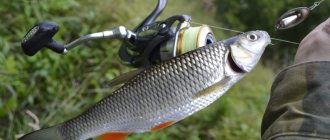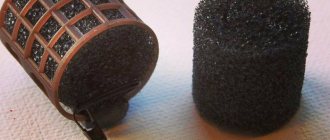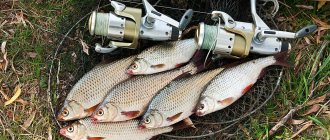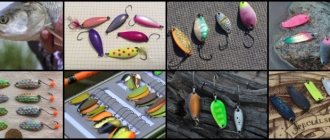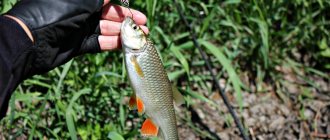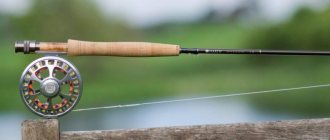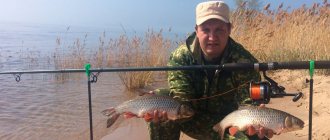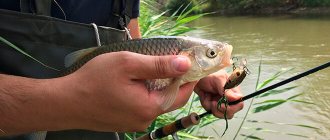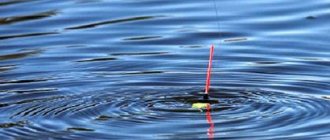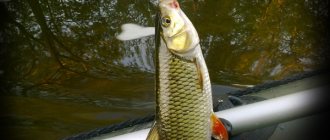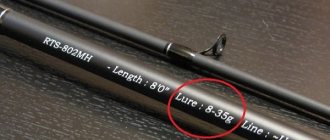Size and lifespan
By the age of 6-10 years, the fish grows in length to 30-50 cm and gains a weight of 2.0-3.0 kg.
These indicators are characteristic of trophy specimens, which are now found quite rarely. Under favorable conditions, individual individuals can live up to 15-20 years. It is in adulthood that there is a significant increase in body length (up to 80-90 cm) and maximum accumulation of mass. The largest ide weighed 8.2 kg and was over a meter (102 cm) tall. Modern standard catches are much more modest. The average weight of fish does not exceed 0.5-1.5 kg, which indicates a significant rejuvenation of the population due to a reduction in the number of places with suitable conditions for long-term development, the growing popularity of sport fishing, and the availability of high-quality gear that can withstand high tensile loads.
Chub, description
The chub also belongs to the carp family. It can reach more than 50 cm in length and weigh up to 8 kg. It is often confused with ide, but the main difference between them is the shape of the head.
The chub has a large mouth, teeth arranged in two rows, powerful jaws. Like many cyprinids, they have pharyngeal teeth.
Thanks to its large mouth and teeth located in the throat, the chub easily copes with the hard chitinous coverings of crustaceans.
The body is cylindrical, elongated and slightly compressed from the sides, which allows it to feel good in the current.
The back is dark, the body itself - the sides and belly are light. The scales are quite large and thick. The fins near the head are almost orange in color, while those on the belly are red.
Differences from roach
Ide, as the most interesting representative of the ray-finned family, is classified as a freshwater species, but sometimes it can also be found in slightly salty water. Juveniles are commonly called roaches. These fish are among the hardiest river inhabitants that can withstand sudden temperature changes and difficult weather conditions.
In Russia they are considered one of the most popular fish. This semi-predator leads a mainly gregarious lifestyle. But he begins to organize flocks only after reaching a certain age.
Quite often, ides are confused with another representative of the carp family - roach (photo). The value of this fish lies in its excellent taste and the benefits that the substances contained in its meat bring.
Ide and roach have quite a lot in common, as can be seen from their descriptions. For habitat, both species choose fresh or slightly salted water bodies. Both ide and roach belong to the category of long-livers, which in natural conditions live up to 15 years without problems.
As for the exterior features, both fish have similar body shapes. It is not so easy to distinguish them. They have equally elongated and rounded bodies. Both representatives of the carp family have the same number of fins - five, located in the same parts of the body, pairs:
- tail;
- dorsal;
- abdominal;
- chest;
- anal.
The main difference between ide and roach is the color of the scales. In the first, it is cast in a rich yellow color. Roaches, on the other hand, have scales that are pale silver in color.
Interesting! Both fish are quite bony.
How to distinguish between ide and chub
To begin with, it is worth noting that ides, chubs and roaches are united by one family - they are all representatives of cyprinids, which also include such well-known river fish species as, in fact, carp, asp, roach, bream, silver carp, carp, tench, crucian carp , cupid and many others.
All cyprinids are characterized by such external signs as:
- the presence of scales on the body and a bare head;
- pronounced premaxillary bones forming the edge of the upper jaw;
- rounded belly without signs of ossification;
- absence of adipose fins;
- the location of the teeth is not in the mouth, but on the lower pharyngeal bones;
- the presence of a pronounced outgrowth at the base of the skull, where the horny plate is located (it is with its help that the fish grinds food before swallowing it);
- one fin on the back.
But if a roach or asp can be recognized based solely on size (the first is one of the smallest representatives of the family, the second is the largest), then the ide, chub and roach are almost the same in size from each other, and, therefore, for their identification you need to be guided by other, more reliable signs.
Among such tips, you should first of all pay attention to the place of catch, since the habitat of the ide and chub is slightly different, in addition, a careful comparison of the two fish with each other indicates that, although they are similar, they still have several characteristic differences .
Did you know? Representatives of the carp family are distributed throughout almost the entire oceans of the world; they are not found only in the waters located south of Mexico. It is interesting that in Australia, where carp were settled relatively recently, today they are the most common fish, the number of which is time to be reduced so as not to upset the balance of the ecosystem.
Habitats
Chub (also known as smut or chub) and ide are predatory fish, and in the warm season they prefer to hunt closer to the surface, lying in wait for fry, various swimmers or small insects that accidentally find themselves in the water. In spring and late autumn, when life on the surface freezes and the small inhabitants of rivers hide in bottom grooves, algae thickets and other secluded places, carnivorous fish of the carp family also move to the depths.
However, if the ide perfectly adapts to changes in temperature and therefore can easily hunt both at great depths and at shallow ones, the smut still prefers shallows, looking out for prey in the thick of coastal aquatic vegetation. Thanks to its high endurance, the ide provides itself with a wider habitat than the more pampered chub: ide, unlike most freshwater fish, can sometimes be caught even in bays with salty sea water.
Important! Both ide and chub are very easy to spook, so it is best to catch such fish from a boat, carefully observing camouflage and avoiding even the slightest noise.
But the ide does not like fast and cold currents, so you will not find this fish in mountain rivers. The chub, on the contrary, never enters places where the water stagnates due to lack of flow, since a clean and oxygenated environment is of fundamental importance for this fish.
For all their external similarity, ide and chub have different characters. The first predator is more tolerant of external conditions, but at the same time it is quite timid and slow. The ide is not picky about the composition of its food, readily accepting both animal and plant food, and therefore many fishermen use bait for herbivores, for example, grain, when catching ide. The muddy and muddy bottom is quite suitable for this fish, since it is easier to find food there.
Find out also about homemade products for winter and summer fishing with diagrams and drawings.
The chub is a fast, swift and aggressive fish, but rather cautious and cunning than timid. You can catch smut only with large animal food; insects are best suited for this purpose - dragonflies, flies, locusts, grasshoppers, caterpillars, butterflies.
And the most favorite delicacy of fish, according to the observations of experienced specialists, is the cockchafer. By correctly selecting the size of the bait, a good fisherman will prevent the bite of fish that are too small in advance, concentrating on waiting for the real catch.
But with regard to the chub, there is one interesting exception to this rule. In places with a strong current, as well as in the presence of natural cover (for example, a bridge support, a sunken tree or dense thickets of algae), the bunts feel safe and greedily pounce on the prey, not paying much attention to the surrounding situation, including the fisherman who is not too secretive.
Pay attention to the information about the features of winter fishing.
So, although the habitat of ide and chub can be characterized as overlapping sets, depending on the chosen fishing location, the probability of catching one predator increases, while the second, on the contrary, decreases.
The general principles here are:
| Signs of a good place for catching ide | Signs of a good place for chub fishing |
|
|
Experienced fishermen, knowing the habits of ide and chub, can unmistakably recognize them even by the nature of their bite: ide, despite its large size, takes the bait carefully and gently. If you startle the fish at this moment, it will hide for a long time or even swim away from the dangerous place.
Find out also about the features of winter vents.
The chub, having tried it on and made up its mind, grabs the hook with such force that it can easily break the leash and even drag the rod along with it. It is for this reason that for hunting smut you need a strong and thick line, while such gear can only scare off an attentive ide.
Appearance
It is much more difficult to distinguish a chub from an ide by external signs than by the place of catch. But by looking closely, the likelihood of error can still be significantly reduced.
The signs that you need to pay attention to first are collected in the form of a table:
| Distinctive feature | Ide | Chub |
| Head | Not very large (proportional to the body), slightly flattened from the sides | Wide, massive, with a pronounced forehead |
| Mouth | Neat, small, obliquely positioned (adapted to small food), with thin and even slightly tender lips | Large, “aggressive”, can accommodate large prey entirely, fleshy lips |
| Eyes | Slightly smaller than the chub, the color is inexpressive - yellowish or yellow-green | Large, light |
| Body Shape | Flattened on the sides, tall (no more than 30–50 cm in length), creates a feeling of imposingness and slowness | Oval, slender, elongated (up to 50–80 cm) and thin, creates a feeling of dynamism |
| Body color | Golden or yellow, sometimes with a greenish tint, monochromatic | Silver, darker back |
| Scale size | Small | Large |
| Anal fin | Elongated and concave inward | Convex, small number of rays |
| Fin color | Dark red | Also red, but brighter and lighter, sometimes closer to orange |
| Meat | Yellowish | Pale pink |
It should, however, be borne in mind that obvious differences in body shape are clearly visible only in young fish: with age, the chub becomes heavier, matures and becomes more rounded. Eyes, head shape and scale color are also unreliable signs, since they are noticeable only when examining two individuals in direct comparison, so the easiest way to distinguish one fish from another is by the anal fin: in the ide it is curved, and in the chub it is concave.
Who is more appetizing - ide or chub?
All carp have white meat of medium fat content with a slightly sweetish taste and, alas, a large number of small bones. At the same time, it is quite tender and very tasty, and therefore is highly valued.
Did you know? The statement about the incredible value of fish for health is fully true only for its marine representatives: in freshwater species there are almost no Omega-3 polyunsaturated fatty acids and such important elements as iodine, selenium, manganese, zinc, fluorine and copper. Therefore, river fish is tasty and satisfying, but more neutral than healthy.
Interestingly, predatory fish are usually more tasty than herbivores, but since both ide and chub in this sense belong to the same category, it is difficult to evaluate them from a culinary point of view. Among consumers, opinions on this matter are divided almost equally, with representatives of both camps defending their position with equal confidence.
Trying to be objective, it can be noted that chub has more calories than ide, which means its meat is a little fattier - 127 kcal per 100 g versus 117 kcal for ide. Another important parameter in determining the taste of river fish is its size, because the larger the individual, the less bony it is, and therefore, the more convenient it is to eat.
On this basis, both representatives of the carp family are in approximately the same category, as evidenced by the following data:
| Characteristic | Ide | Chub |
| Average length, cm | 28–35 | 50–80 |
| Maximum length | 70–90 | 80 |
| Average weight, kg | 0,5–3 | 1,5–2 |
| Maximum weight, kg | 6–8 | 5–8 |
| Average age, years | 11–12 | 15–18 |
Thus, it can be argued that between the ide and the chub, the specific specimen that is larger is tastier.
Description and dimensions
The appearance of the ide is quite attractive due to the multi-colored scales throughout the body. In the photo you can see what ide looks like. The gill wings of the fish are covered with golden scales, the back is dark blue, and the belly has a silver tint.
The fish acquires a bright appearance during the spawning period. Moreover, mature ides have a more saturated color than young individuals.
Knowing the description of ide, it cannot be confused with other types of rocks. The eyes have a yellowish-greenish tint. The fins are red, especially the rear and ventral ones.
Ide is one of the most common fish species of the carp family. In the northern latitudes of Russia it is as popular as carp and is even an alternative to it.
The ide is an omnivorous semi-predator, leading a gregarious lifestyle up to a certain age, organizing flocks based on age. The larger and older the individuals in it, the less numerous they are; large fish prefer to stay alone, forming temporary aggregations only when absolutely necessary - during wintering and during spawning migrations.
It tolerates salinity of water up to 10 g/l, so it can settle in river deltas and in slightly salted sea areas. The usual length of caught individuals is 30-50 cm with a weight of 0.6-2.0 kg, giants weighing up to 5-7 kg and height 90-100 cm.
In Russia, the rules of recreational and sport fishing regulate the minimum size of fish caught; for ide it is 28 cm. Smaller specimens must be released.
The e-book “Fishing for Beginners” will answer all your questions and will be the best assistant in mastering this activity. More details
The average life expectancy of Ya* is from 8 to 10 years. In places inaccessible to humans with a good food supply, such as in taiga Siberian rivers, they live up to 20 years. In some regions of their range, ide is an important commercial object, making up the majority of fish caught.
Yazis are loners. They gather in flocks only when going to spawn. The animals are very cautious, sensitive to noise, and like to stay at great depths, which makes fishing difficult.
In winter, these fish are active, especially in the morning. As they move, they search for food and water saturated with oxygen. The bait is often ignored because they are not greedy like ruffs, gobies and perches. They go into wintering pits only in frosty weather.
In spring, activity intensifies. The animal moves into the tributaries of its reservoir to lay eggs and feed on worms and larvae, which melt water carries into streams.
In summer, ides move from the depths to surface waters. This is due to the fact that insects often fall on a river or lake mirror, which they readily eat. Small specimens (roaches) like to feed near eroded banks under overhanging branches or layers of turf, especially after rain. Currents and rainwater carry insects, worms, mollusks, larvae, and aquatic plants there.
A large representative of the species may also appear here, feeding on fry, roaches, roaches (roach is a good food item for a large specimen, since cannibalism is characteristic of a larger number of fish). Adults prefer to hunt from shelters, such as algae, trees that have fallen into the water, and bridge supports.
In autumn, the main food becomes not insects, which are already scarce, but young fish. The fry gather at the surface of the water, covered with fallen leaves, where they feed on plankton, plant and animal. There they are caught by ides, whose appetite increases at this time of year. They eat not only fish, but also frogs, and are also ready to take any bait, including artificial bait.
External differences of ide
We recommend watching a very useful video: What makes ide stand out:
- thick and short body;
- green-yellowish eyes or yellow with a dark splash at the top;
- medium-sized gray scales;
- in spring, the color becomes more eye-catching - the fish shimmers with silver and golden colors under the sun's rays;
- the fins on the back and tail are dark, but sometimes reddish, the lower and lateral fins are always red;
- the back is black and blue, the sides are whitish, the belly is silver.
Rice. 1. What does ide look like?
Description and dimensions
Ide is a very beautiful fish. Its scales have a golden sheen, especially a lot of yellow on the gill covers, while the back is black and blue, and the belly is silver. This fish looks most elegant during spawning; adult specimens are much brighter in color than roaches.
When done, the head looks small and has a slanting mouth at the bottom. The eyes have a yellow iris with a greenish tint. The fins are colored red, the anal and ventral ones are especially bright. The average weight of an adult ide is from one and a half to two kilograms with a body length of forty to fifty centimeters, although record specimens reach the six-kilogram mark.
Ide is often confused with other representatives of carp fish, especially with species such as chub and roach.
When our hero is caught in the bycatch with the specified fish, the differences are still visible to the naked eye, for example, the ide differs from the chub in the following ways:
- taller body;
- less wide head;
- small mouth;
- small scales.
The differences from roach are also very obvious:
- yellow eyes;
- small scales;
- light back.
Taste characteristics
Asp meat is recognized as the best. However, it has one significant drawback - bonyness. You can get rid of this by salting. Under the influence of salt, the bones soften. If you smoke the fish again after this, they will not be noticeable at all.
It is recommended to make minced meat from asp meat and then make cutlets. This fish goes well with pork, so when passing through a meat grinder they can be mixed.
Ide meat has a muddy smell, but not a very strong one. To get rid of it, the fish must be soaked in salt water. It is best to fry the roach, this will soften its bones.
Chub meat is considered dietary. However, it has a strong muddy smell, which many people do not like. To get rid of it, fish can be marinated in lemon juice with garlic and herbs. After this, prepare any dish from the chub.
Rice. 4. Ide, chub, and asp make very tasty dishes, even despite their bonyness and the smell of mud. After processing, these shortcomings can be eliminated. That is why fishermen love them so much.
As it became clear, ide, chub and asp have many differences, especially visible in adult individuals. In addition to their appearance, they also differ in their behavior, so the technology for catching them will be different, which must be taken into account when going fishing.
Distribution and habitats
Ide is widespread in Europe and Asia. Ide is found in greater or lesser quantities in all European countries and in most of Siberia; it is not found only in Southern and Southwestern Europe, starting with eastern France. In Russia it has a very wide distribution and is found almost everywhere, with the exception of the Far North itself; in Finland it is found above the Arctic Circle; also quite common in the Northern Dvina and, according to Kessler, reaches Pechora. Ide has not been found in Transcaucasia.
It is most numerous in the rivers of the Volga basin and in central and eastern Russia, and in the south it is found in smaller numbers; in the lower reaches of large rivers it is even very rare, and in the Dniester it is not found at all. Beyond the Urals, it belongs to the most common fish, especially in the lakes of Perm and Orenburg provinces, and goes very far to the east, at least to Lake Baikal, and perhaps further. In the Turkestan region, ide is replaced by another closely related species, and it was also not found in the Caucasus.
Distribution and habitats of ide
Ide lives in rivers with moderate currents. In them, it chooses deep places with a silt-clay or cartilaginous bottom, among snags, near whirlpools, bridges, piles and other structures, as well as below riffles with a slightly slower flow. The ide also lives near the shores under trees hanging over the water, as well as near muddy streams, in river bays among rare thickets of plants, it also enters floodplain lakes (of which it prefers flowing ones). In search of food, it can go out into shallow riffles and also rise to the surface of the water. Young individuals live in small flocks, while older ones lead a predominantly solitary lifestyle. For the winter, older individuals gather in flocks, which increase in size in deep-sea areas. In winter, ides lead an active lifestyle and lie down only in the most severe frosts.
Character and lifestyle
How to smoke hot smoked fish
In the summer, the ide family of fish stays closer to the shore. Thus, it is easier for him to take care of his food. It is much easier and more practical for adult specimens of these fish to remain in splendid isolation. Young fish mostly stay in schools.
In winter, both of them try to group and live together. This is a fairly hardy fish. It is not difficult for her to tolerate varying degrees of water temperature and contamination. But to a greater extent, it gives preference to waters with springs and springs.
It is known about the ide fish that it is very careful. Any noise or the slightest danger makes her react with lightning speed. In most cases, the fish instantly tries to move back, jumping from the water into the air when leaving. His sense of smell is well developed, so he can smell aromatic bait from afar.
In the winter season, ide goes to the depths and remains there until the end of winter. Experienced fishermen say that ides coexist with perches. With the arrival of spring, fish begin to gather in schools and rise to the surface of the banks. And as the rivers become free of ice, flocks of ides rise upstream.
At a time when the ice disappears and the rivers flood, flocks of ide are located near the banks. But he does not move further than the river bed. This is explained by the fact that they begin to spawn quite early. The eggs of the ide fish will not die from the rapid decline of spring waters if they remain in the river bed. Many fishermen have noticed that ides can rise up to a distance of 150 km.
After spawning, they hide in the depths of the reservoir. Only after some time can they be seen on the sandbanks, where they rise to feed. It is at this time that it is possible to catch ide using any method, from a fishing rod to other fishing gear.
Reproduction and growth of ide
It begins to spawn at the age of 3 to 5 years. Spawning begins when the water temperature reaches 8 degrees Celsius. Spawns at depths of up to 1 meter, looking for a pebble bottom or just a bottom with uneven surfaces (river ide). Lake ide spawns in reeds. Fertility can reach 110 thousand eggs. In many regions, ide spawning coincides with high water.
The growth of ide cannot be called linear, that is, it depends on living conditions. However, this can be said about many species of fish that live in Russia. If we take average values, then in the third year of life it can reach a mass of 270 grams, in the fifth – 500-550 grams. The growth rate of ide is higher than that of some other representatives of cyprinids (for example, chub), but significantly lower than that of many other fish (pike, trout, etc.).
How to easily distinguish an asp from a chub
There is an opinion among beginning spinning fishermen that the difference between these predators is minimal, and therefore finding the differences here is very difficult. Let's try to dispel this myth.
Appearance
Asp and chub are typical predators of large and small Russian rivers. This is where their similarities end. We list the main differences:
The chub has much larger scales and has a golden-green hue. In the sheresper it is silver, with a pronounced blue.
It is logical that a fish that got its name because of the shape of its head should have a rather unusual head. In the chub it is disproportionately large and has a rounded shape. The asp is more harmonious in its proportions. It is appropriate to mention here one of the main differences - the jaws. Asps, having the status of a predator, have rather weak “offensive weapons”. With a powerful jaw, almost all of its teeth are nothing more than a semblance of tubercles or protrusions. The chub is more dangerous in this regard. Moreover, his pharyngeal teeth (those located at the very throat) are extremely powerful. They are located in two rows.
On a note! Powerful jaws allow chubs to easily cope even with the chitinous shells of river crustaceans and mollusks.
Another sign that allows you to distinguish an asp from a chub is the color and shape of its fins. The first one has a truncated anal fin and is much narrower, but nature did not spare red paint for the second one.
Habits
To be fair, we note that these predators are not only different in appearance. The differences in habits and disposition are obvious here. Sheresper is clearly stronger and therefore, when chasing prey, he even manages to jump out of the water. Its prey can include butterflies, beetles and other insects flying low over the water surface, as well as small birds.
The chub is more careful in this regard. His tactics are to attack from cover or from deep.
Features of spawning
Suitable places for fish are found in areas of melt water spills. Since the fish spawn relatively early, the hatched fry have time to leave the drying up spills and go into the river. As soon as the ice begins to melt on the river, mature ides begin to rise upstream. At this time, fish travel considerable distances, sometimes hundreds of kilometers.
Spawning begins in April - May, depending on the region, at a water temperature of 6-8 degrees. If the weather is favorable, this process does not take long.
Ide can spawn in just a couple of days.
Spawning occurs in the morning or evening. In stable weather, this process may take all night. The ide tries to attach its eggs to underwater vegetation, snags or stones. However, the current often carries the eggs down, where they become prey for other fish or simply die.
After one or two weeks, fry emerge from the surviving eggs. Without leaving the spawning grounds, they eat plankton and other small organic matter. The fry grows quickly and at the age of one year can gain weight up to 100 grams. One-year-old roaches switch to a full diet, occasionally eating small fish.
During the spawning period, ide is practically not interested in food. He begins to eat heavily after he gets sick. At this time, fish are caught well with worms and bloodworms; some fishermen specifically wait for prey.
Asp, description
Asp is another representative of the carp family. It has a massive, shortened and at the same time thick body, with large silvery scales.
The carcass has an uneven grayish color. The back is dark with a gray-blue tint, the sides are silver-blue, and the belly is white.
The fins, front and bottom, with a gray tint at the tips, become darker. The dorsal fin is sharp, long and thin.
A very powerful tail, thanks to which it stuns its victims, the lower half is longer than the upper. An elongated head with a massive lower jaw and a large mouth.
There are no teeth, only pharyngeal teeth. Instead, there are jaw bumps and depressions, thanks to which it is able to strongly hold the victim.
The asp prefers clean, oxygenated water. Inhabits medium-flow rivers, flowing lakes and ponds. Hunts mainly near the surface, on small fish.
Small individuals live in schools and feed mainly on worms and bloodworms; by the age of two they become predators.
The asp grows very quickly and is considered one of the largest and most aggressive fish among cyprinids.
The average size of specimens is 2-2.5 kg. with a length of 60 cm, but trophy specimens reached 12 kg. weight and size just over a meter.
Catching ide
You can catch ide all year round, with the exception of 1-2 months in winter, when the frost is the most severe. Large ide bite more actively when the water warms up to 14 degrees. The most active bite is in the early morning. It is better to look for ide in pools, holes, under trees hanging over the water, on the border of currents and near river mouths.
You can catch ide with any gear, from the shore and from a boat, most often with a bottom and float fishing rod, less often with a Bolognese fishing rod, a match rod, with a retrieve and a spinning rod. Fly fishing close to the surface is popular in the summer. In autumn, ide sinks closer to the bottom. In winter they fish with a regular winter fishing rod with a strong rod.
The bait may be the simplest, but fragrant. Ide likes the smell of vanilla, burnt bones, sheep's blood, birch branches, and sunflower oil. Bait can be purchased, or you can make it yourself based on grain, cake, bread with the addition of earth, clay, sand. When fishing on rivers you will need a lot of bait, on lakes - less, but the bait should have a stronger aroma.
In the spring the bait is a worm, small crawler, caddisfly, bloodworm, jig, bark beetle; in the summer it also bites on insects - dragonflies, grasshoppers and their larvae, and on greens: mulberry, reed shoots. By autumn it even feeds on fry and bites on wobblers. In winter they catch it with a spoon and a jig with a piece of fish, a jig, a worm, a maggot, a bark beetle, a leech, peas or dumplings made from semolina or flour.
The ide bites more boldly if you don’t make any noise and go into the water up to your knees. His bite is confident, but short, requiring a quick hook. When playing, it fights to the last and often goes away. When catching ide, a landing net, a yawner and an extractor can be useful.
Quite a numerous commercial species in many parts of its range. It is caught everywhere by amateur fishermen and has value as an object of sport fishing.
Fishing Features
Both amateurs and athletes show interest in catching ide. Moreover, you can catch this type of fish all year round. Fish may not bite only in severe frosts and during the spawning period. You can fish with any fishing rod. The most effective include:
- wired;
- Bolognese;
- flywheel;
- spinning;
- match.
In winter, the fisherman will have to stock up on special gear that will prevent the float from freezing to the ice.
The highest feeding activity usually occurs a week after the completion of spawning. This period usually lasts about three weeks. When choosing bait, it is important to consider that the ide has a small mouth. It is better to use those that are no larger than size two. The length of the spoon should not exceed 4 cm.
The description of the method of catching this fish requires adherence to special recommendations. So, you need to fish in silence, trying not to make unnecessary noise, since the ide is a very shy fish. It is advisable to camouflage yourself with the surrounding area. For float fishing, you can use plant-based baits and various wobblers.
In freedom he is very strong and agile. Once hooked, the fish begins to twist in every possible way and jump out of the water. Often he manages to cut the line with his fin and free himself from captivity.
Photo of ide fish
Fishing methods
How to cook asp at home: recipes for delicious fish dishes
Ide is a popular object of sport and recreational fishing. Fishing for ide is carried out in a variety of ways.
In summer, ide is more active before dawn and at sunset. In winter, on frosty days, the ide is not active, preferring to stand at depth; during the thaw, the probability of catching an ide is highest. In January and February, the ide is the most passive of the entire year and hardly feeds at all.
After spawning, a period of feeding begins, when the ide tries to feed almost around the clock, replenishing the reserves spent on wintering and spawning. With the arrival of autumn cold weather on the eve of winter, ide begins a second, but weaker, period of zhora, lasting 3-4 weeks. During the feast, ide relaxes its vigilance, so it becomes easier prey than at other times of the year.
Catching ide is possible using almost all known methods:
- on a float rod
- for spinning
- on the donk
- to the feeder
- fly fishing
Ide is very timid and cautious, can hear human speech very well and senses footsteps along the shore, so when fishing it is advisable not to talk, not to make sudden movements, to walk very carefully and quietly
Float rod
For catching ide, it is better to choose a monofilament with a thickness of 0.22 mm. When catching ide on a float rod, natural plant baits have proven themselves to be effective: grains of boiled corn, canned peas slightly dried in the sun, dough, bread, lumps of semolina porridge. The ide has a well-developed sense of smell, so you can add a little vanilla or sunflower oil to the bait, which will better attract the ide.
You can use filamentous algae from the reservoir where you fish. You need to look for them in the water on snags, rocks, near the piles of bridges and piers. Algae works especially well on hot sunny days. To prepare bait from algae, you need to take its youngest parts, 8-10 cm long. One tip of the shoot is carefully tied to the shank of the hook and braided around it. The second tip remains free (1-2 cm).
The ide bites well on beetles, all kinds of larvae, especially chafers and bark beetles, dung worms, caddis flies, dragonflies, grasshoppers, dragonfly nymphs, maggots, and mayflies. Tadpoles, small frogs, fry and small fish are suitable for bottom fishing. The ide bite is fast and confident; the angler should always be ready in order to have time to hook. The ide bites quickly, the float instantly disappears under the water. When fished, it desperately resists and can jump out of the water.
For winter fishing they use bloodworms and worms.
Spinning
Ide is not very actively caught on a spinning rod, since it is, after all, not a predator. When fishing from the shore, it is better to choose the standard rod length of 2.7 meters; when fishing from a boat 2.4 meters; test up to 15 grams. Reel size up to 3000. Before an obvious bite, small pokes first follow.
Since most ides are not very large and have a very small mouth, baits should be chosen in small sizes: rotating spoons from 0 to 2, oscillating spoons no more than 4 cm long.
Description
A fairly well-known, widespread large freshwater fish, which has some commercial significance and is also the object of recreational fishing. Young individuals of ide are usually called roaches.
External signs
The ide has a moderately elongated, somewhat tall, and at the same time noticeably thickened body. The head is small, with a convex forehead. The number of scales in the lateral line is from 55 to 63. The caudal and anal fins are notched. The mouth is small, terminal, directed obliquely upward, its apex located below the middle of the eye. Gill rakers are shortened, sparse, their number is from 10 to 13.
Quite recognizable, however, sometimes it can be confused with other fish of the carp family, especially young individuals.
Coloring
The scales of the ide are silvery-shiny and have a slight golden tint; the same shade is clearly visible on the gill covers. The back is dark, with a bluish tint - the dorsal and caudal fins have approximately the same color. The sides of the fish are noticeably lighter; the color of the scales on the belly is white-silver. In adult ides, the anal and pelvic fins are bright red with a crimson tint; in juveniles, which are lighter in color, they are somewhat paler. There may also be a reddish tint in the color of the remaining fins. The iris of the eye is yellow, with a slight greenish tint, darker in the upper part.
During spawning, the color of the ides becomes noticeably brighter, and the shine of the scales becomes more intense. In the sun's rays, its color shimmers from silver to golden.
External gender differences
Outwardly, it is quite difficult to distinguish between male and female ide, although there is evidence that the latter, unlike the former, are less brightly colored. During the spawning period, determining the sex of the fish is much easier, since the heads of males are covered with epithelial tubercles.
Dimensions, weight
Most often you come across individuals ranging from 30 centimeters to half a meter in length, weighing from half a kilo to one and a half kilograms. Large ides - from two kilograms or more - are much less common. The maximum weight that an ide can reach is 8 kg with a length of almost a meter. The maximum age that ides reach in nature is 15-20 years.
Similar fish species
The ide is somewhat reminiscent of the chub, from which it differs in a taller body, noticeably smaller scales, a slightly smaller head and a narrower mouth slit, as well as a concave edge of the anal fin.
Small roaches are similar in appearance to common roaches; their main difference from the latter is the yellow iris of the eye (in roaches it is usually orange-red). In addition, in roach the anterior edge of the dorsal fin is located almost in line with the anterior edge of the ventral fins; in ide, the dorsal fin is noticeably shifted closer to the tail.
Also, ide has more scales in the lateral line than chub and roach.
Ecological forms and subspecies
In different bodies of water, ide can form slight variations in color and body shape. Fish that live in rivers are slimmer and lighter than lake ides, and they also differ somewhat in behavior. A separate subspecies, the Turkestan ide, lives in the Aral Sea basin.
In past centuries, selective breeding resulted in the development of a domestic breed of ide, the Golden Orpha.
The pharyngeal teeth of the ide are double-rowed, arranged according to the formula 5.3 - 3.5, and in appearance they somewhat resemble the pharyngeal teeth of the asp. The number of vertebrae varies from 44 to 46.
Useful properties of ide
Freshwater fish - representatives of cyprinids, which include carp, bream, tench, roach, crucian carp, carp, asp, ide and silver carp - have long been highly valued as a source of complete protein and vitamins.
Ode meat contains 117 kcal, rich in protein, potassium, phosphorus, also contains calcium, magnesium, sodium, chlorine, iron, fluorine, chromium, molybdenum, nickel, as well as vitamin PP, etc.
Ide is very easily and quickly digestible. Boiled or baked, it is an indispensable product for dietary nutrition. Fish is especially useful for heart diseases, as well as gastritis and gastric ulcers.
One of the main values of Ide is protein with a unique ratio of essential amino acids. The most valuable of them are tryptophan, lysine, methionine and taurine.
Ide meat contains very important minerals: calcium and phosphorus. Its regular use protects against osteoporosis and strengthens teeth and bones.
Ukha and freshwater fish aspic are excellent dishes to stimulate digestion. The extractives in the broth increase the secretion of gastric juice and pancreatic enzymes. Therefore, both ukha and aspic are useful for gastritis with low acidity.
Dangerous properties of ide
Salted and dried river fish are contraindicated for hypertensive patients and patients with severe kidney disease.
Ide bonefish, accidentally swallowing a fish bone can cause intestinal damage.
The beneficial and dangerous properties of ide depend on the cleanliness of the reservoir in which it was caught.
That's how much positivity a Yayayaz caught with one's own hands can bring! The video shows a successful fisherman genuinely happy about the fish he caught. This video has currently received more than 7 million views on YouTube, and its author, Viktor Nikolaevich Goncharenko, has become a living legend of the Internet.
Places and habitat features of ide
Ide prefers places at medium depths, with moderate currents. The favorite habitats of this fish are with leafy or sandy-pebble soil. Ide readily settles in areas located among algae with clean soil. You can find this fish in snags, but not with a muddy bottom. The favorite habitats of ide include holes below riffles, boundaries of weak and strong currents, whirlpools with a calm circular current, quiet water below bridge supports, piers, trees lying in the water, and barges. It often happens that ide can be found at the mouth of a stream or river, in water clouded after rain. In small rivers, ide is found right next to steep banks in places where branches of trees or bushes hang over the water. In search of food, ides come out at night onto sandbanks and shallow riffles, which are located near pits and rapids. In summer, especially during mass reproduction of insects, ide feeds at the very surface of the water.
Young ide usually live in small flocks, while adults prefer to live alone. But for the winter, regardless of age, ides gather in flocks. The number of these flocks increases significantly during the freeze-up period. In winter, ide is quite active; it sticks to deep places, which are often snagged. An ide can only get into a hole in severe frosts or bad weather. As soon as the ice begins to melt, ides rush in flocks to the spawning grounds. Ide spawn early, starting with water temperatures still at 5-13 °C. This fish comes out to spawn in large schools and spawns for one to two weeks. Female ide spawn directly in the spring floods. In those years when the flood is small or from those places where it does not happen at all, the ide goes to spawn in small rivers, in which the middle flow contains places with a sandy-pebble or gristly bottom.
The ide is not picky in its diet; it eats a wide variety of aquatic vegetation, mollusks, crustaceans, worms, insects and their larvae. And having reached a weight of 500-600 g, the ide begins to feed on small fish.
Active fishing for ide in some reservoirs (usually small rivers) begins in early spring, at a time when the melt water subsides and until it clears, because during this period the ide go to spawn in large flocks, feeding intensively along the way.
Ide can also be caught from the ice in winter, more successfully during periods of thaw, especially towards the end of winter.
Fish diet
The ide is an omnivorous fish. Its menu includes worms, bloodworms, mollusks, and crustaceans. In summer, ide eats aquatic vegetation and insects. The menu for adult ide also includes juvenile fish. With the onset of autumn, it begins to willingly eat small frogs.
Due to the fact that ide is a very cautious and shy fish, successful fishing requires very competent camouflage. It is for this purpose that people very often fish from a boat when catching it. Experienced fishermen also use bait and bait. With the onset of spring, in the morning hours, the ide bites for up to an hour and a half. In the summer, morning bites increase to 2 hours. In autumn, ide, both in the morning and in the evening, can peck for up to 3 hours in a row.
Weather also greatly affects the frequency of ide bites. The fish take best on warm but cloudy days. You can try fishing on a hot summer day, but only on condition that there will be short-term rains. If no precipitation is expected during the heat, then you can only hope for bites in the early morning and late evening hours.
In the spring, after the ide has finished spawning, you can catch it with a regular worm. In summer, fish begin to bite well on caddis flies, dragonflies, bark beetles, shells, and also on grain. In autumn it is worth using frogs as bait. The ide should be fed with small maggots and ant eggs. Bait should be done 2 hours before fishing.
Catching bersh in winter
In winter, bershi also predominate in catches, even if the purpose of fishing was pike perch. From the ice, bershi are excellently caught using luminous jigs with sprat, luminous spinners “admirals” and the so-called Swedish “pimples” - spoons with an uneven, bumpy coating, as well as various balancers, among which the Mebaru balancers stand out for their effectiveness. As a rule, luminous baits are most effective when fishing from ice. If the bait has a regular coloring, it is often equipped with a light-accumulating strip. In addition, when fishing for bersh, it is advisable to attach cut sprat to any bait. This is the key to success.
I recommend to read:
Fishing for pike perch and bass from ice
Catching pike perch and bersh in early spring with jigs and balancers
Reproduction
The ide begins to spawn when the water temperature rises to 12 degrees Celsius. In the middle regions of our country, this period begins at the moment when the flood begins to subside. During this period, the rivers begin to flow back into their banks. This period occurs in the second half of April or the beginning of May. During the spawning period, river ide begins to migrate upstream in order to choose the most favorable place for spawning.
Ide usually begins to subside in the early morning hours or late evenings. Most often, this process takes place along the current, and less often in the reed area. The most favorite places are deep places, with a rocky bottom, underwater hummocks, snags, etc. The ide goes to spawn after reaching 2 years of age and gaining up to 300 grams in weight. Males are usually much larger than females, but they are smaller in size. The ide goes to the spawning grounds in large flocks, including hundreds and sometimes even thousands of individuals.
During this life cycle, males are dotted with many small tubercles on their scales, which, in fact, is a difference from females. The caviar has a yellowish tint (photo below). The average ide is capable of sweeping up to 70 thousand eggs. The larvae begin to hatch from the eggs already on the 10th day. At first, the larvae try to stick to their hatching sites.
Salted ide caviar
The ide is a freshwater fish. Which belongs to the carp family. This fish is of quite significant importance in fishing. Often bred as a sport fishing object. Ide has very tasty, but very bony meat (photo above), which often smells of algae.
